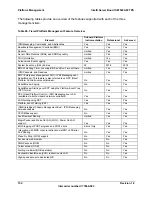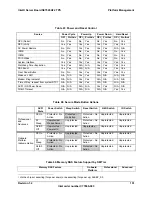
Intel® Server Board SE7520AF2 TPS
System BIOS
Revision 1.2
145
Intel order number C77866-003
5.15.2
Format of the OEM Binary Structure
If this structure is not present, that is, if the mask bit 01 is not set, the system BIOS assumes
that the user binary is not mandatory, and it is required in runtime.
Table 64: Format of OEM Binary Structure
Offset Bit
Definition
0h
Bit 0
1 if mandatory user binary, 0 if not mandatory.
If a user binary is mandatory, it will always be executed. If a platform supports a disabling of the user
binary scan through CU, this bit will override CU setting.
Bit 1
1
If runtime presence required (other than SMM user binary portion, SMM user binary will always be
present in runtime irrespective of setting of this bit)
0, if not required in runtime, and can be discarded at boot time.
Bit 7:2 reserved for future expansion
1 - 0Fh
Reserved for future expansion
5.16 Quiet Boot / OEM Splash Screen
The BIOS implements Quiet Boot to fulfill the Hardware Design Guidelines 3.0 requirement that
the BIOS provide minimal startup display during BIOS POST. System start-up must only draw
the end user’s attention in case of errors or when there is a need for user action. By default, the
system must be configured so that the local screen does not display memory counts, device
status, and so on. It must present a "clean" BIOS start-up. The only screen display allowed is
the OEM splash screen and information such as copyright notices.
The Quiet Boot process is controlled by a Setup Quiet-Boot option. If this option is set, BIOS
displays an activity indicator at the top of the screen and a Logo splash screen in the middle
section of the screen on the local console. The activity indicator measures POST progress and
continues until the Operating System gains control of the system. The splash screen covers up
any diagnostic messages in the middle section of the screen. While the logo is being displayed
on the local console, remote text consoles display diagnostics messages.
Quiet Boot may be disabled by clearing the Setup Quiet-Boot option or by the user pressing the
<Esc> key while in Quiet Boot mode. If Quiet Boot is disabled, BIOS displays diagnostic
messages in place of the activity indicator and the splash screen.
BIOS allows users to override the standard Intel logo with their own logo.
5.17 Operating System Boot, Sleep, and Wake
5.17.1
Microsoft* Windows* Compatibility
Intel Corporation and Microsoft* Corporation co-author design guides for system designers
using Intel
®
processors and Microsoft* operating systems. These documents are updated yearly
to address new requirements and current trends.
PC200x specifications are intended for systems that are designed to work with Windows 2000
and Windows* XP class operating systems. The
Microsoft Hardware Design Guide
for the
Windows* XP platform is intended for systems that are designed to work with Windows XP class
operating systems. Each specification classifies the systems further and has requirements






























